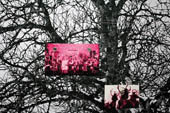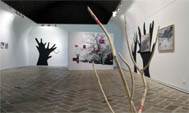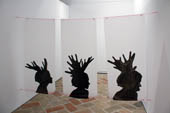Maite Garbayo Maeztu
Ura ixuririk sorginen bidean
dohaina bildu dut Bazko arratsean
gauaz Mayi nuzu, egunaz oreina
etxeko zakurrek xerkatzen nutena*
azuring
There is a woman with stag antlers. There are several. They are all the same one. Sometimes the deers have
horns too. Adarra: branch, horn. In the ground there is a dead bush in the middle of the gypsum clay, whose dry branches rise up. Water.
Everything comes from the form. It all begins when hands cast their shadows on the wall, against the light. The shadow is the place where the light is blocked. The other side to where the hidden bursts out. The shadow is the desire to be which escapes. The remainder.
Like a game: the hands move and that which doesn’t exist, appears. Hands-branches-horns-stags. Before the shadow was strange, now I am aware that I’m the shadow. I want to dominate it. Escape. There is always
something dark that I don’t recognise, and in which I can’t recognise myself. The shadow was there. Before.
Outside. Inside. On the ground. It was the first representation. Representation?
Azuring – Deep sky-blue like the dusk. The woman who casts her shadow on the wall, appears in the snow. It is
time for sunset. She has stag horns.
They told me that in Orreaga, on the way up to Ibañeta, a shepherd heard songs from behind the rocks. There
was a stag with a brilliant radiance between his antlers. He brought the carving of the virgin. The lady of the Pyrenees. In the evening, or it could have been the night. The stag had announced the coming of the virgin, in other nearby places, always in the mountains. But I only heard about it that once.
In old Europe, tales are told about a birth-giving goddess, who turned into a deer. The same thing happened in many places, far and wide. I wonder what is the connection between the animal with horns and the one who gives life. Virgin, goddess, seductress. I want to hear this story once again.
Like the woman in the snow, in Ireland and Scotland there were priestesses who wore stag skins and horns on their heads. The women turned into stags and the stags into women. Just like the woman who cast her shadow on the wall.
She is the one who never goes back. The one who gets free and breaks away. Her shadow. Once everything was immediate. Only what was around existed. The goddess who gave life was sometimes a stag. Deer?
They wore masks and horns. And danced. Just like the fuchsia-coloured photographs. They fastened the horns with straps so that they could dance. Were they men? No, they weren’t. There were also women. What does it mean to be a man or to be a woman? What’s the difference, that doesn’t matter, now.
Yes, there were also men. Not just those who danced in Abbots Bromley. (The men from the pink photos).They were there before. In the cave of Les Trois Fréres, more than fifteen thousand years ago, someone painted a human with stag horns. They called him “the sorcerer”. He seems to be standing there, staring at you. He has owl eyes because they see everything. They see everything.
The woman with the dark silhouette would also like to see everything, that’s why she casts her shadow to the other side. It is a negative of her.
Even nearer, in the caves of Ekain, there are two stags among lots of horses. In the gallery of Auntzei, stag and deer have been engraved in the rock. Several more in the cave of Altxerri. And in the one at Alkerdi, near Urdax. A small closed cave. The head of a stag appears. Only the head.
They have been here for ages. It is said that “they had reached symbolism”. As if symbolism had been afterwards. After what? I ask myself if it had not been before. The woman of the shadow wants to return, to go further and further back… She can’t. What she wants is to face the impossible.
They live in the perfection of having died.
Engraved stag antlers have been found. They have zigzags, vs, silhouettes. They are almost everywhere. They make associations, construct linguistic corpus, visuals. I would like them to be encrypted. In order to generate questions which can drag you out into the open.
A musical instrument made from stag antler was found in Altzeta. It is thousands of years old. Two holes. They say it looks like an alboka.
I would like to say a bit more about goddesses. From what is left. From what we can guess, when we try to rebuild it. What gives life also takes it away. Carries it away. Recreates it. It is a multi-form. They are all shapes and forms and at the same time none in particular.
The Sumerian goddess of child-birth was also a stag. The stag, the water, the amniotic fluid. Artemis came out of Leto’s belly first and then she helped to deliver his brother Apollo. On the island of Ortigia. Hera was forbidden to give birth anywhere under the sun: nowhere. The Moirae, who weave destiny, named her mid-wife. And the stag is by her side. Pausanias wrote about a statue of Artemis. He was dressed in deer skin.
Some deer have antlers. Not all of them, but some do.
When I went in, I thought it lacked colour. It is shadow time. The sunset. Everywhere something is lost. Before night falls. The myth bursts out. There are many things, too many!
Before I left, I saw she had taken the shape of a sculpture. Of three shapes. The woman with the stag horns repeats herself. Once and again. She refuses to recognise herself or be recognised in all or any forms. She converts. Once and once again. Repeats-repeats-repeats.
The shadow that she casts helps her to distance herself. From what? From the woman with the shadow. From her own reflection.
Maite Garbayo Maeztu. 2011
*Part of an old Basque song. Laffite, Pierre, “Atlantika Pirineetako sinheste zaharrak”, Gure Herria, 1965, p.22.



